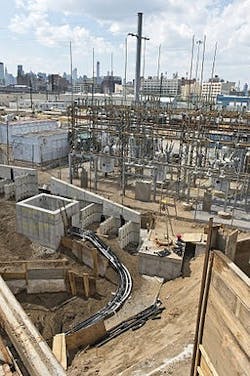Queens, NY. Credit: MTA of NY
Two New York utilities are circulating solicitations for energy storage and non-wire alternatives in keeping with the state’s Reforming the Energy Vision (REV) policy.
Consolidated Edison (ConEdison) and the New York State Electric & Gas (NYSEG) are acting under direction from the New York Public Service Commission. The regulatory agency is in the early stages of bringing theory into practice for REV, a sweeping reinvention of electric policy and markets meant to open the door to greater use of distributed energy resources and customer participation in energy markets.
ConEdison seeks demonstration projects that test the hypothesis that utilities can derive significant market-based earnings from integrating energy storage onto their electric systems.
The request for information does not mandate any particular approach but encourages creative experiments.
By way of example, the utility said that projects might show how to use storage to reduce operating expenses and peak demand or manage distributed energy resources. Or they could provide customer benefits, such as power quality or reliability, ease in managing bills, or participation in wholesale markets.
ConEdison is limiting its funding for the projects to no more than $25 million. A project can cost more as long as the funding comes from another source. The projects must have a minimum capacity/energy of 100kW/400kWh per installation. And the total project size, including all storage, should be at least 4 MWh.
Responses to the RFI are due to ConEdison on March 25. Called Innovative Energy Storage Business Models, the RFI is available here.
Separately, New York State Electric & Gas has issued a request for proposals for distributed energy resources that can reduce peak loading on a 5-MW transformer bank. The utility hopes to defer an upgrade at its Java substation, in the utility’s west pricing zone.
NYSEG is open to considering projects that use distributed generation, demand response, energy efficiency, energy storage, or other non-wire alternatives that can solve the problem.
There are certain projects the utility will not consider, such as distributed energy already located within the service area. It also will not accept fossil fuel proposals, except those that use natural gas or propane.
The NYSEG projects are expected to be in service by January 2018. Bids are due April 8. Called the “Request for Proposal: Java Substation Non-Wire Alternative,” the NYSEG RFP is available here.
NYSEG isn’t the first New York utility to pursue non-wire alternatives to postpone substation upgrades. ConEdison already has a program underway designed to defer a $1 billion substation upgrade in Brooklyn/Queens.
Track utility solicitations for energy storage and non-wire alternatives by subscribing to the Energy Efficiency Markets newsletter. It’s free.
About the Author
Elisa Wood
Editor-in-Chief
Elisa Wood is the editor and founder of EnergyChangemakers.com. She is co-founder and former editor of Microgrid Knowledge.
